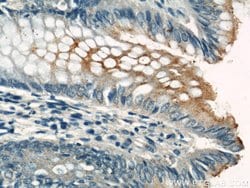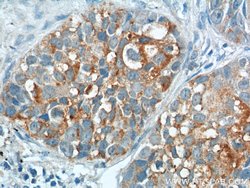missing translation for 'onlineSavingsMsg'
Learn More
Learn More
CEA Rabbit anti-Human, Polyclonal, Proteintech
Rabbit Polyclonal Antibody
145.00€ - 410.00€
Spécification
| Antigène | CEA |
|---|---|
| Concentration | 0.2 mg/mL |
| Applications | Immunohistochemistry (Paraffin) |
| Classification | Polyclonal |
| Conjugué | Unconjugated |
| Code produit | Marque | Quantité | Prix | Quantité et disponibilité | |||||
|---|---|---|---|---|---|---|---|---|---|
| Code produit | Marque | Quantité | Prix | Quantité et disponibilité | |||||
|
16806803
|
Proteintech
10421-1-AP-20UL |
20 μL |
145.00€
20µL |
Veuillez vous connecter pour pouvoir commander cet article. Besoin d'un compte web? Créer le vôtre dès maintenant! | |||||
|
16896793
|
Proteintech
10421-1-AP-150UL |
150 μL |
410.00€
150µL |
Veuillez vous connecter pour pouvoir commander cet article. Besoin d'un compte web? Créer le vôtre dès maintenant! | |||||
Description
CEA (Carcino Embryonic Antigen, CD66e) is synthesized during development in the fetal gut, and re-expressed in increased amounts in intestinal carcinomas and several other tumors. CEA is a member of carcinoembryonic antigens, immunoglobulin supergene family and consists of a single N domain (structural homology to the immunoglobulin variable) and six immunoglobulin constant-like A (A1, A2, A3) and B domains (B1, B2, B3). Antibodies to CEA are useful in identifying the origin of various metastatic adenocarcinomas and in distinguishing pulmonary adenocarcinomas (60 to 70% are CEA+) from pleural mesotheliomas (rarely or weakly CEA+). CEA is a member of a large family of glycoproteins, a useful tumor marker for adenocarcinoma, and found in adenocarcinomas of endodermally derived digestive system epithelium and fetal colon. Two subgroups of the CEA family, the CEA cell adhesion molecules and the pregcy-specific glycoproteins, are located within a 1. 2 Mb cluster on the long arm of chromosome 19. Eleven pseudogenes of the CEA cell adhesion molecule subgroup are also found in the cluster. CEA was originally described in bile ducts of liver as biliary glycoprotein. Subsequently, CEA was found to be a cell-cell adhesion molecule detected on leukocytes, epithelia, and endothelia. The encoded protein mediates cell adhesion via homophilic as well as heterophilic binding to other proteins of the subgroup. Multiple cellular activities have been attributed to the encoded protein, including roles in the differentiation and arrangement of tissue three-dimensional structure, angiogenesis, apoptosis, tumor suppression, metastasis, and the modulation of innate and adaptive immune responses. Multiple transcript variants encoding different isoforms have been reported, but the full-length nature of all variants has not been defined.Spécification
| CEA | |
| Immunohistochemistry (Paraffin) | |
| Unconjugated | |
| Rabbit | |
| Human | |
| P06731 | |
| 1048 | |
| CEA Fusion Protein Ag0672 | |
| Primary | |
| -20°C | |
| CEACAM5 |
| 0.2 mg/mL | |
| Polyclonal | |
| Liquid | |
| RUO | |
| PBS with 50% glycerol and 0.1% sodium azide; pH 7.3 | |
| Carcinoembryonic antigen, CD66e, CEA, CEACAM5, Meconium antigen 100 | |
| CEACAM5 | |
| IgG | |
| Antigen Affinity Chromatography | |
| Antibody |
Vous avez repéré une opportunité d'amélioration ?Partager une correction de contenu
Correction du contenu d'un produit
Veuillez fournir vos retours sur le contenu du produit en remplissant le formulaire ci-dessous.
Nom du produit







